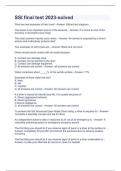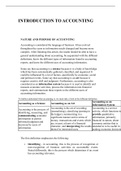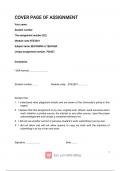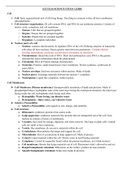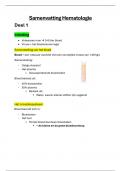Roth: Insight into SOM: A research agenda 13-09-2019
Service encounter: the customer contact points at which the customers meet and interact with
the service provider (moments of truth).
Target market: who, the right customers
o Demographic characteristics: age, income
and education.
o Operational attributes: customer contact,
process labor intensity, customization
Service concept: what, the total bundle of goods
and services sold to the customer and the relative
importance of each component to the customer.
o Supporting facilities: physical and structural resources that must be in place for
the service to be delivered.
o Facilitating goods: materials, supplies
and merchandise that are used or
consumed in the service delivery
process.
o Facilitating information: supports or
enhances the execution of explicit
services.
o Explicit services: the customer’s
experiental or sensual benefits.
o Implicit services: psychological
benefits or more tacit aspects of the
service that customers may sense only
vaguely.
Service delivery system:
o Strategic service design choices
Structural choices: e.g. facilities, technology, capacity, etc.
Infrastructural choices: e.g. programs, policies, leadership, performance
management, service standards.
Integration choices: extrenal integration, internal integration, adaptive
mechanisms.
o Service delivery system execution, renewal and assessment
o Customer-perveiced value of the service concept
Research agenda:
1. Broadening service operations strategy
2. Redefining operations resources
3. Focus on customer experiences
4. Expanding service operations boundaries
5. Issues in implementing service technology and E-services.
Ostrom et al.: Service Research Priorities in a Rapidly Changing Context :
, The context in which service is delivered and experienced has, in many respects, fundamentally
changed. For instance, advances in technology, especially information technology, are leading to a
proliferation of revolutionary services and changing how customers serve themselves before, during,
and after purchase. To understand this changing landscape, the authors engaged in an international and
interdisciplinary research effort to identify research priorities that have the potential to advance the
service field and benefit customers, organizations, and society. The priority-setting process was
informed by roundtable discussions with researchers affiliated with service research centers and
networks located around the world and resulted in the following 12 service research priorities:
1. Stimulating service innovation
2. Facilitating servitization, service infusion,
and solutions
3. Understanding organization and employee
issues relevant to successful service
4. Developing service networks and systems
5. Leveraging service design
6. Using big data to advance service
7. Understanding value creation
8. Enhancing the service experience
9. Improving well-being through
transformative service
10. Measuring and optimizing service
performance and impact
11. Understanding service in a global context
12. Leveraging technology to advance service.
Hagiu & Wright: Do you really want to be an e-bay?
Most companies that serve as intermediaries between buyers and sellers face a fundamental strategy
decision: Should they be resellers (like supermarkets), acquiring and then reselling products or
services? Should they operate as multisided platforms (like eBay), cormecting buyers and sellers
without controlling or owning the offerings being sold? Or should they blend the two models?
The attractions of multisided platforms have enticed many companies, large and small, to try to apply
the model in cases where the reseller model would have had a better chance of succeeding all
attempts have failed.
Choosing the right model four critical factors
1. Scale effects: high-demand products are sold efficiently by one large reseller.
2. Aggregation effects: more value created when sold together, resellers can exploit
complementary relationships.
3. Buyer and seller experiences: matching buyers and sellers, or single agent preferred.
4. Market failures: uncertainty about the reliability of sellers, suppliers or product quality.
Managers and investors should consider where on the continuum between pure reseller and pure
multisided platform a company belongs and understand that it may take one or more moves to get
there. This involves assessing which model will best allow the business to exploit scale and
aggregation effects, offer a better buyer or seller experience, and resolve market failures such as
uncertainty about product quality or the reliability of sellers or suppliers. After establishing the
business, managers must remember to reevaluate its position as the competitive landscape changes.
Otherwise, the business could be disrupted.
Service encounter: the customer contact points at which the customers meet and interact with
the service provider (moments of truth).
Target market: who, the right customers
o Demographic characteristics: age, income
and education.
o Operational attributes: customer contact,
process labor intensity, customization
Service concept: what, the total bundle of goods
and services sold to the customer and the relative
importance of each component to the customer.
o Supporting facilities: physical and structural resources that must be in place for
the service to be delivered.
o Facilitating goods: materials, supplies
and merchandise that are used or
consumed in the service delivery
process.
o Facilitating information: supports or
enhances the execution of explicit
services.
o Explicit services: the customer’s
experiental or sensual benefits.
o Implicit services: psychological
benefits or more tacit aspects of the
service that customers may sense only
vaguely.
Service delivery system:
o Strategic service design choices
Structural choices: e.g. facilities, technology, capacity, etc.
Infrastructural choices: e.g. programs, policies, leadership, performance
management, service standards.
Integration choices: extrenal integration, internal integration, adaptive
mechanisms.
o Service delivery system execution, renewal and assessment
o Customer-perveiced value of the service concept
Research agenda:
1. Broadening service operations strategy
2. Redefining operations resources
3. Focus on customer experiences
4. Expanding service operations boundaries
5. Issues in implementing service technology and E-services.
Ostrom et al.: Service Research Priorities in a Rapidly Changing Context :
, The context in which service is delivered and experienced has, in many respects, fundamentally
changed. For instance, advances in technology, especially information technology, are leading to a
proliferation of revolutionary services and changing how customers serve themselves before, during,
and after purchase. To understand this changing landscape, the authors engaged in an international and
interdisciplinary research effort to identify research priorities that have the potential to advance the
service field and benefit customers, organizations, and society. The priority-setting process was
informed by roundtable discussions with researchers affiliated with service research centers and
networks located around the world and resulted in the following 12 service research priorities:
1. Stimulating service innovation
2. Facilitating servitization, service infusion,
and solutions
3. Understanding organization and employee
issues relevant to successful service
4. Developing service networks and systems
5. Leveraging service design
6. Using big data to advance service
7. Understanding value creation
8. Enhancing the service experience
9. Improving well-being through
transformative service
10. Measuring and optimizing service
performance and impact
11. Understanding service in a global context
12. Leveraging technology to advance service.
Hagiu & Wright: Do you really want to be an e-bay?
Most companies that serve as intermediaries between buyers and sellers face a fundamental strategy
decision: Should they be resellers (like supermarkets), acquiring and then reselling products or
services? Should they operate as multisided platforms (like eBay), cormecting buyers and sellers
without controlling or owning the offerings being sold? Or should they blend the two models?
The attractions of multisided platforms have enticed many companies, large and small, to try to apply
the model in cases where the reseller model would have had a better chance of succeeding all
attempts have failed.
Choosing the right model four critical factors
1. Scale effects: high-demand products are sold efficiently by one large reseller.
2. Aggregation effects: more value created when sold together, resellers can exploit
complementary relationships.
3. Buyer and seller experiences: matching buyers and sellers, or single agent preferred.
4. Market failures: uncertainty about the reliability of sellers, suppliers or product quality.
Managers and investors should consider where on the continuum between pure reseller and pure
multisided platform a company belongs and understand that it may take one or more moves to get
there. This involves assessing which model will best allow the business to exploit scale and
aggregation effects, offer a better buyer or seller experience, and resolve market failures such as
uncertainty about product quality or the reliability of sellers or suppliers. After establishing the
business, managers must remember to reevaluate its position as the competitive landscape changes.
Otherwise, the business could be disrupted.



